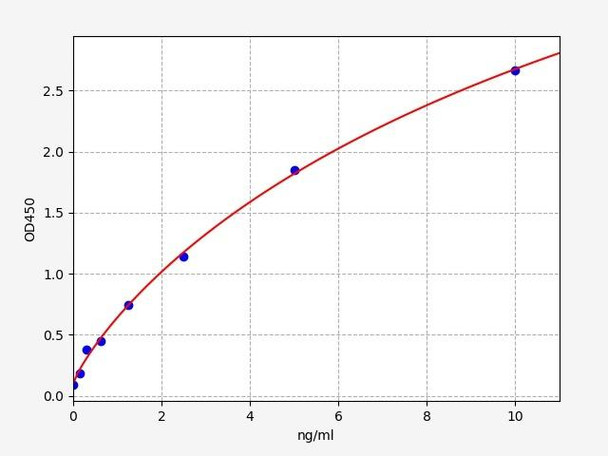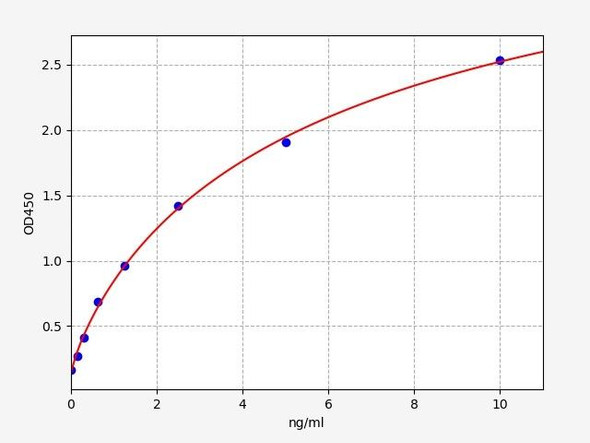Rat Immunology ELISA Kits 2
Rat cPLA2 / Cytosolic phospholipase A2 ELISA Kit
- SKU:
- RTFI00690
- Product Type:
- ELISA Kit
- Size:
- 96 Assays
- Uniprot:
- P50393
- Sensitivity:
- 0.094ng/ml
- Range:
- 0.156-10ng/ml
- ELISA Type:
- Sandwich
- Synonyms:
- Cpla2, PLA2G4A, cPLA2, Cytosolic phospholipase A2, cPLA2-alpha, calcium-dependent phospholipid-binding protein, lysophospholipase, phosphatidylcholine 2-acylhydrolase, Phospholipase A2 group IVA, phospholipase A2, group IVA, cytosolic, calcium-depend
- Reactivity:
- Rat
- Research Area:
- Metabolism
Description
| Product Name: | Rat Cpla2 (Cytosolic Phospholipase A2) ELISA Kit |
| Product Code: | RTFI00690 |
| Size: | 96 Assays |
| Target: | Rat Cpla2 |
| Alias: | Cpla2, PLA2G4A, cPLA2, Cytosolic phospholipase A2, cPLA2-alpha, calcium-dependent phospholipid-binding protein, lysophospholipase, phosphatidylcholine 2-acylhydrolase, Phospholipase A2 group IVA, phospholipase A2, group IVA, cytosolic, calcium-dependent |
| Reactivity: | Rat |
| Detection Method: | Sandwich ELISA, Double Antibody |
| Sensitivity: | 0.094ng/ml |
| Range: | 0.156-10ng/ml |
| Storage: | 4°C for 6 months |
| Note: | For Research Use Only |
| Recovery: | Matrices listed below were spiked with certain level of Rat Cpla2 and the recovery rates were calculated by comparing the measured value to the expected amount of Rat Cpla2 in samples. | ||||||||||||||||
| |||||||||||||||||
| Linearity: | The linearity of the kit was assayed by testing samples spiked with appropriate concentration of Rat Cpla2 and their serial dilutions. The results were demonstrated by the percentage of calculated concentration to the expected. | ||||||||||||||||
| |||||||||||||||||
| Intra-Assay: | CV <8% | ||||||||||||||||
| Inter-Assay: | CV <10% |
| Uniprot: | P50393 |
| UniProt Protein Function: | cPLA2: a calcium-dependent phospholipase A2 that catalyzes the release of arachidonic acid from membrane phospholipids. Selectively hydrolyzes arachidonyl phospholipids in the sn-2 position releasing arachidonic acid. Arachidonic acid is a precursor for the eicosanoids that are involved in hemodynamic regulation, inflammatory responses, and other cellular processes. Promotes cerebellar long-term depression and motor learning. Translocates to the Golgi and endoplasmic reticulum in a calcium-dependent fashion. Translocation and activation of at the ER facilitates the process of ER stress. Regulates the biogenesis of lipid droplets, a process dependent on JNK and ceramide kinase. Stimulated by agonists such as ATP, EGF, thrombin and bradykinin as well as by cytosolic Ca2+. The N-terminal C2 domain, by its association with lipid membranes, mediates the regulation of CPLA2 by presenting the active site to its substrate in response to elevations of cytosolic Ca2+. Inhibited when in trimolecular complex with ANXA2 and S100A10. Phosphorylation of S727 relieves this inhibitory interaction, thus activating PLA2G4A. |
| UniProt Protein Details: | Protein type:EC 3.1.1.4; EC 3.1.1.5; Lipid Metabolism - alpha-linolenic acid; Lipid Metabolism - arachidonic acid; Lipid Metabolism - ether lipid; Lipid Metabolism - glycerophospholipid; Lipid Metabolism - linoleic acid; Phospholipase Chromosomal Location of Human Ortholog: 13q21 Cellular Component: cytoplasm; cytosol; endoplasmic reticulum; Golgi apparatus; intracellular membrane-bound organelle; lipid particle; nucleus; perinuclear region of cytoplasm Molecular Function:calcium ion binding; calcium-dependent phospholipase A2 activity; calcium-dependent phospholipid binding; histone acetyltransferase binding; phospholipase A2 activity Biological Process: aging; arachidonic acid metabolic process; arachidonic acid secretion; decidualization; icosanoid biosynthetic process; luteolysis; ovulation from ovarian follicle; positive regulation of apoptosis; positive regulation of bone mineralization; positive regulation of cell proliferation; positive regulation of fever; positive regulation of inflammatory response; positive regulation of prostaglandin biosynthetic process; positive regulation of vesicle fusion; regulation of cell proliferation; response to calcium ion; response to glucocorticoid stimulus; response to heat; response to hormone stimulus; response to hydrogen peroxide; response to lipopolysaccharide; response to lithium ion; response to methylmercury; response to organic nitrogen; response to organic substance; response to vitamin D; surfactant homeostasis |
| NCBI Summary: | catalyzes the synthesis of COX-2 substrate arachidonic acid (AA); may play a role in epileptogenesis [RGD, Feb 2006] |
| UniProt Code: | P50393 |
| NCBI GenInfo Identifier: | 1709551 |
| NCBI Gene ID: | 24653 |
| NCBI Accession: | P50393.1 |
| UniProt Related Accession: | P50393 |
| Molecular Weight: | 85,707 Da |
| NCBI Full Name: | Cytosolic phospholipase A2 |
| NCBI Synonym Full Names: | phospholipase A2 group IVA |
| NCBI Official Symbol: | Pla2g4a |
| NCBI Official Synonym Symbols: | Pla2c; cPLA2; Pla2g4 |
| NCBI Protein Information: | cytosolic phospholipase A2 |
| UniProt Protein Name: | Cytosolic phospholipase A2 |
| UniProt Synonym Protein Names: | Phospholipase A2 group IVAIncluding the following 2 domains:Phospholipase A2 (EC:3.1.1.4)Alternative name(s):Phosphatidylcholine 2-acylhydrolase |
| Protein Family: | Cytosolic phospholipase |
| UniProt Gene Name: | Pla2g4a |
| Step | Procedure |
| 1. | Set standard, test sample and control (zero) wells on the pre-coated plate respectively, and then, record their positions. It is recommended to measure each standard and sample in duplicate. Wash plate 2 times before adding standard, sample and control (zero) wells! |
| 2. | Aliquot 0.1ml standard solutions into the standard wells. |
| 3. | Add 0.1 ml of Sample / Standard dilution buffer into the control (zero) well. |
| 4. | Add 0.1 ml of properly diluted sample ( Human serum, plasma, tissue homogenates and other biological fluids.) into test sample wells. |
| 5. | Seal the plate with a cover and incubate at 37°C for 90 min. |
| 6. | Remove the cover and discard the plate content, clap the plate on the absorbent filter papers or other absorbent material. Do NOT let the wells completely dry at any time. Wash plate X2. |
| 7. | Add 0.1 ml of Biotin- detection antibody working solution into the above wells (standard, test sample & zero wells). Add the solution at the bottom of each well without touching the side wall. |
| 8. | Seal the plate with a cover and incubate at 37°C for 60 min. |
| 9. | Remove the cover, and wash plate 3 times with Wash buffer. Let wash buffer rest in wells for 1 min between each wash. |
| 10. | Add 0.1 ml of SABC working solution into each well, cover the plate and incubate at 37°C for 30 min. |
| 11. | Remove the cover and wash plate 5 times with Wash buffer, and each time let the wash buffer stay in the wells for 1-2 min. |
| 12. | Add 90 µL of TMB substrate into each well, cover the plate and incubate at 37°C in dark within 10-20 min. (Note: This incubation time is for reference use only, the optimal time should be determined by end user.) And the shades of blue can be seen in the first 3-4 wells (with most concentrated standard solutions), the other wells show no obvious color. |
| 13. | Add 50 µL of Stop solution into each well and mix thoroughly. The color changes into yellow immediately. |
| 14. | Read the O.D. absorbance at 450 nm in a microplate reader immediately after adding the stop solution. |
When carrying out an ELISA assay it is important to prepare your samples in order to achieve the best possible results. Below we have a list of procedures for the preparation of samples for different sample types.
| Sample Type | Protocol |
| Serum: | If using serum separator tubes, allow samples to clot for 30 minutes at room temperature. Centrifuge for 10 minutes at 1,000x g. Collect the serum fraction and assay promptly or aliquot and store the samples at -80°C. Avoid multiple freeze-thaw cycles. If serum separator tubes are not being used, allow samples to clotovernight at 2-8°C. Centrifuge for 10 minutes at 1,000x g. Removeserum and assay promptly or aliquot and store the samples at-80°C. Avoid multiple freeze-thaw cycles. |
| Plasma: | Collect plasma using EDTA or heparin as an anti-coagulant. Centrifuge samples at 4°C for 15 mins at 1000 × g within 30 mins of collection. Collect the plasma fraction and assay promptly or aliquot and store the samples at -80°C. Avoid multiple freeze-thaw cycles.Note: Over haemolysed samples are not suitable for use with this kit. |
| Urine & Cerebrospinal Fluid: | Collect the urine (mid-stream) in a sterile container, centrifuge for 20 mins at 2000-3000 rpm. Remove supernatant and assay immediately. If any precipitation is detected, repeat the centrifugation step. A similar protocol can be used for cerebrospinal fluid. |
| Cell Culture Supernatant: | Collect the cell culture media by pipette, followed by centrifugation at 4°C for 20 mins at 1500 rpm. Collect the clear supernatant and assay immediately. |
| Cell Lysates: | Solubilize cells in lysis buffer and allow to sit on ice for 30 minutes. Centrifuge tubes at 14,000 x g for 5 minutes to remove insoluble material. Aliquot the supernatant into a new tube and discard the remaining whole cell extract. Quantify total protein concentration using a total protein assay. Assay immediately or aliquot and store at ≤ -20°C. |
| Tissue Homogenates: | The preparation of tissue homogenates will vary depending upon tissue type. Rinse tissue with 1X PBS to remove excess blood & homogenizein 20ml of 1X PBS (including protease inhibitors) and store overnight at ≤ -20°C. Two freeze-thaw cycles are required to break the cell membranes. To further disrupt the cell membranes you can sonicate the samples. Centrifuge homogenates for 5 mins at 5000xg. Remove the supernatant and assay immediately or aliquot and store at -20°C or-80°C. |
| Tissue Lysates: | Rinse tissue with PBS, cut into 1-2 mm pieces, and homogenize with a tissue homogenizer in PBS. Add an equal volume of RIPA buffer containing protease inhibitors and lyse tissues at room temperature for 30 minutes with gentle agitation. Centrifuge to remove debris. Quantify total protein concentration using a total protein assay. Assay immediately or aliquot and store at ≤ -20 °C. |
| Breast Milk: | Collect milk samples and centrifuge at 10,000 x g for 60 min at 4°C. Aliquot the supernatant and assay. For long term use, store samples at -80°C. Minimize freeze/thaw cycles. |






